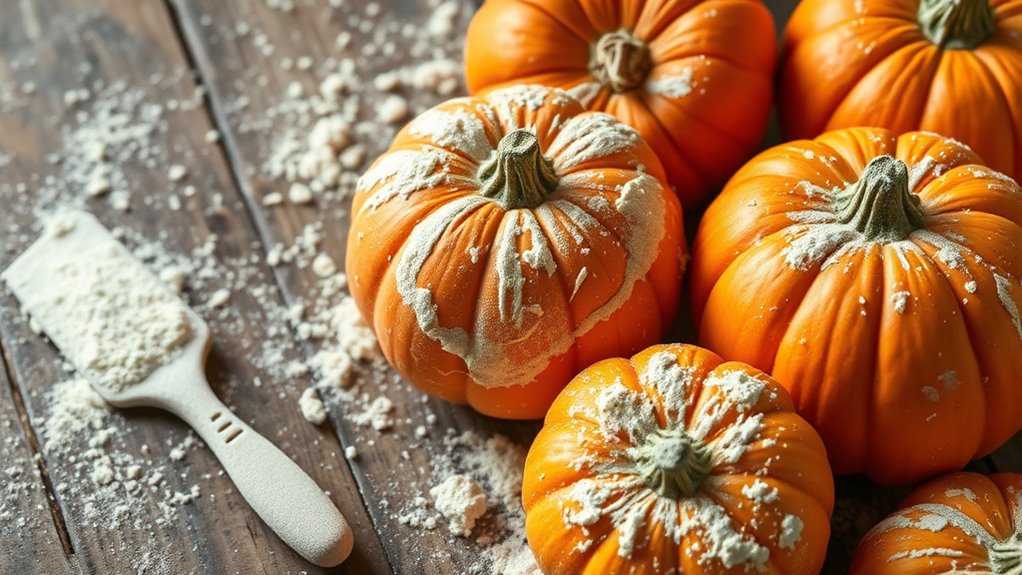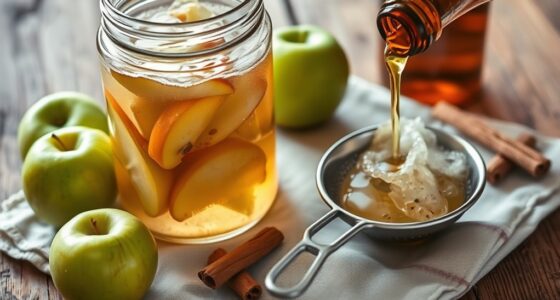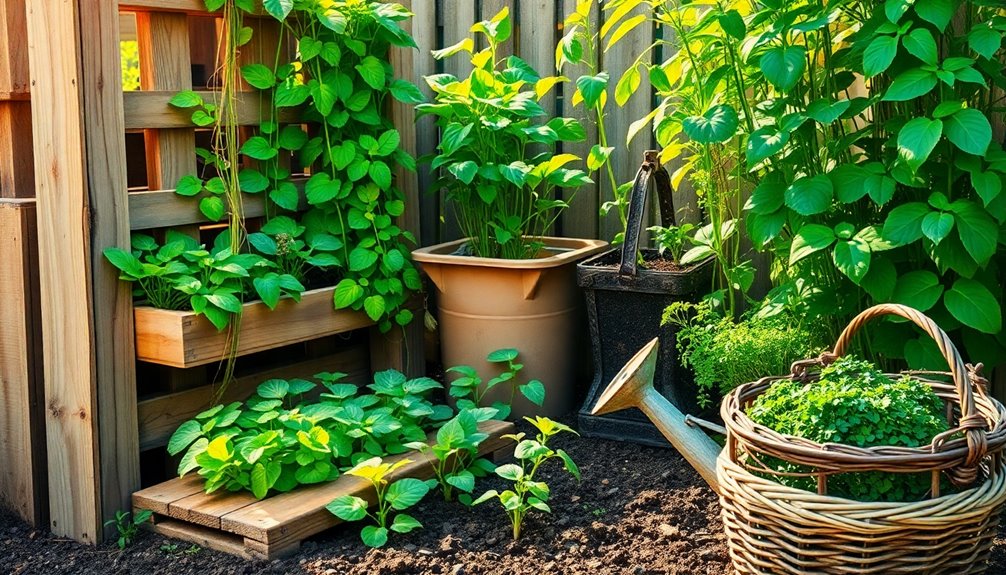To preserve pumpkins with lime paste, first select firm, mature pumpkins with smooth skin. Mix hydrated lime with water to create a smooth, thick paste, then evenly coat the entire surface, including stems and crevices. Store the pumpkins in a cool, dry, well-ventilated area, ensuring proper airflow and regular inspection. Applying lime paste helps prevent decay and extends freshness. If you want detailed steps to keep your pumpkins fresh longer, keep exploring for more tips.
Key Takeaways
- Select firm, mature pumpkins with smooth skin and avoid blemishes for effective preservation.
- Prepare a smooth lime paste by mixing hydrated lime with water before application.
- Evenly coat all surfaces of the pumpkin, including stems and crevices, with the lime paste for optimal protection.
- Store pumpkins in a cool, dry, well-ventilated area to prevent spoilage and maintain freshness.
- Regularly inspect and remove any mold or soft spots to prolong pumpkin preservation.
Gathering and Preparing Your Pumpkins
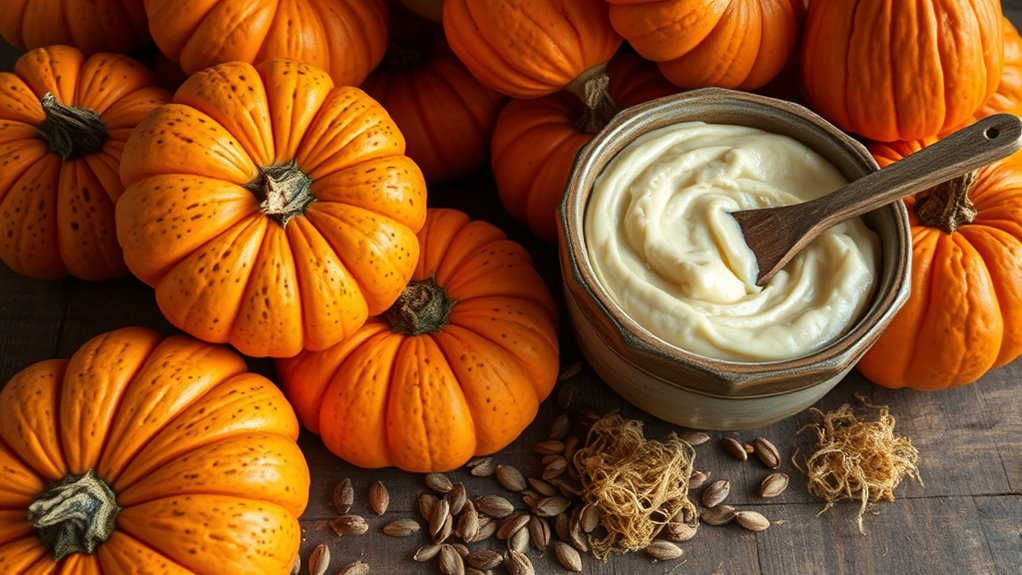
Have you ever wondered how to choose the best pumpkins for preservation? Selecting the right pumpkin varieties is key. Look for firm, heavy pumpkins with smooth, unblemished skin. Avoid soft spots, cracks, or mold, which signal spoilage. When it comes to harvesting techniques, use a sharp knife or pruning shears to cut the stem about 2 inches above the pumpkin. Handle them carefully to prevent damage. Harvest pumpkins when they’re fully mature, usually indicated by a deep color and hard rind. Timing matters—don’t pick too early or too late. Properly harvested pumpkins will last longer and preserve better. Additionally, understanding the importance of proper curing techniques can significantly enhance the storage life of your pumpkins. Once harvested, gently clean off dirt and set them in a cool, dry place. Proper curing involves maintaining optimal temperature and humidity, which is crucial for long-term storage. You can also improve preservation by ensuring good ventilation, which helps prevent moisture buildup and mold during storage. This careful approach guarantees your pumpkins are primed for successful preservation.
Making the Lime Paste Mixture

After selecting and harvesting your pumpkins, the next step is to prepare the lime paste mixture, which plays an essential role in the preservation process. To achieve the right lime paste consistency, mix hydrated lime with water until you get a smooth, thick paste that isn’t too runny or too stiff. Proper pumpkin surface preparation is vital before applying the paste; ensure the pumpkins are clean and dry. Use a brush or your hands to spread the lime paste evenly over the entire surface, covering all ridges and crevices. The paste should be thick enough to stick without dripping, providing a protective coating. This careful preparation helps seal the pumpkin’s surface, preventing decay and preserving it for longer periods. Additionally, understanding the properties of the lime paste can enhance its effectiveness in preservation techniques and ensure your pumpkins last longer. Incorporating knowledge of sound design can even help in creating instructional videos or audio guides to demonstrate the preservation process effectively. Proper application and curing of the lime paste are crucial for maximizing its protective qualities, which can be further optimized through consistent messaging to educate users about best practices, ensuring the longevity of your preserved pumpkins. Recognizing the importance of environmental factors can also influence the success of the preservation process, helping you adapt techniques for different conditions.
Applying Lime Paste to the Pumpkins

Once the lime paste mixture is prepared, carefully apply it to the pumpkins by spreading it evenly over the entire surface using a brush or your hands. Aim for a lime paste consistency that is smooth but thick enough to adhere well without dripping. As you work, consider the pumpkin surface texture; a slightly rough surface helps the paste stick better, so ensure the pumpkins are clean and dry beforehand. Cover every part of the pumpkin, including the stem and crevices, to create an even, protective layer. Applying the paste in a steady, controlled manner to prevent gaps or uneven coverage guarantees the lime paste forms a uniform coating that will effectively preserve your pumpkins and shield them from decay. Staying informed about legislative changes can help you adapt your preservation methods for better results. Additionally, choosing recycled materials for any tools or containers used can further enhance your environmentally friendly approach. Proper application techniques also contribute to achieving consistent coverage, ensuring the preservation process is as effective as possible. Incorporating effective preservation methods, such as proper drying and storage, can extend the lifespan of your preserved pumpkins even further. Being aware of market demand influences the choice of preservation techniques, especially if you plan to sell your pumpkins later.
Proper Storage Techniques

Proper storage is key to maintaining the quality of your preserved pumpkins. To keep them fresh, focus on pest prevention and moisture control. Store your pumpkins in a cool, dry place away from direct sunlight. Use breathable containers or layers of straw to prevent moisture buildup that can lead to rot. Regularly check for pests or signs of mold, as early detection helps prevent spoilage. Keep the storage area clean and well-ventilated to discourage insects and fungi. Proper storage techniques are essential for ensuring your pumpkins stay preserved and delicious for longer. Here are some tips to help you:
- Cover pumpkins with breathable cloth or mesh to keep pests out
- Maintain consistent temperature and humidity levels
- Inspect storage regularly for moisture or pest issues
- Ensuring proper airflow helps reduce the risk of mold growth and spoilage
- Incorporating moisture control methods can further extend shelf life and prevent decay
- Utilizing knowledge of SQA best practices can improve your storage management and prevent quality deterioration.
- Implementing regular maintenance routines can help detect issues early and keep your pumpkins in optimal condition.
Tips for Maintaining Freshness and Quality
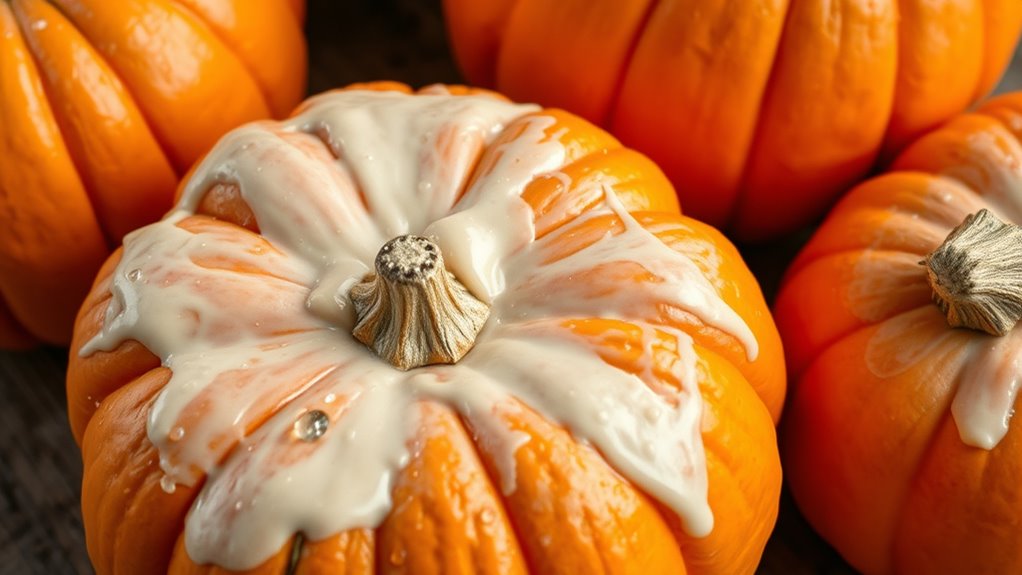
To keep your preserved pumpkins fresh and high-quality, it’s essential to handle them carefully and monitor their condition regularly. When pumpkin carving or using them as seasonal decorations, avoid damaging the skin, which can lead to quicker spoilage. Keep the pumpkins in a cool, dry place away from direct sunlight to slow deterioration. Check for soft spots or mold, and remove any affected areas promptly. Applying lime paste helps maintain moisture and prevents decay, but it’s still important to inspect the pumpkins often. Proper storage conditions ensures your pumpkins stay vibrant and intact longer, whether they serve as festive decorations or are preserved for future use. Additionally, sound healing techniques can be utilized to create a calming environment during pumpkin preservation activities, promoting relaxation and focus. Regular air quality monitoring can also help ensure your storage area remains optimal for preserving organic materials like pumpkins.
Frequently Asked Questions
How Long Can Pumpkins Be Preserved Using Lime Paste?
You might wonder how long pumpkins last with preservation techniques like lime paste. Generally, lime paste can extend their shelf life to several months if stored properly in a cool, dry place. It’s a traditional method that helps prevent decay and pests. Just keep in mind, the effectiveness hinges on proper application and storage conditions. Regularly check the pumpkins to ensure they stay fresh and safe to use over time.
Is Lime Paste Safe for Edible Pumpkins?
Did you know that lime paste has been used for centuries in food preservation? When considering pumpkin safety, lime paste ingredients typically include calcium hydroxide, which, if used correctly, can help preserve pumpkins safely. However, improper use or excessive lime paste can cause safety issues. Always guarantee you’re following proper guidelines to avoid contamination or health risks, and consult trusted sources for safe application methods.
Can Lime Paste Be Used on All Pumpkin Varieties?
When considering lime paste application, you might wonder about pumpkin variety compatibility. You can generally use lime paste on most pumpkin varieties, but it’s best to check specific guidelines for each type. Some pumpkins with thin skins or delicate flesh may not tolerate lime paste well. To guarantee effective preservation, test on a small area first, and adjust your method based on the pumpkin’s individual characteristics.
What Are the Environmental Impacts of Using Lime Paste?
When considering the environmental impacts of using lime paste, you should think about its environmental footprint. Lime production can generate carbon emissions and waste, but it’s relatively eco-friendly compared to synthetic options. You might explore eco-friendly alternatives like natural preservatives or organic methods that reduce environmental harm. By choosing sustainable options, you help lower your overall impact and support environmentally conscious practices in food preservation.
Are There Alternative Methods to Lime Paste for Pumpkin Preservation?
Imagine uncovering secret methods to keep your pumpkins fresh longer. You might wonder if natural preservatives or chemical alternatives exist beyond lime paste. Yes, options like salt, vinegar, or even honey can act as preservatives, creating a barrier against spoilage. These methods are safer and more eco-friendly, but they require precise application. Explore these alternatives carefully—they could be your key to preserving pumpkins without relying on lime paste.
Conclusion
By following these simple steps, you can effectively preserve your pumpkins and enjoy their beauty longer. Did you know that lime paste can extend pumpkin freshness by up to two weeks? That’s a huge boost for your seasonal decorations or harvest displays. So, next time you’re preparing pumpkins, try this natural preservation method. It’s easy, eco-friendly, and keeps your pumpkins looking vibrant and fresh much longer. Give it a go and impress your friends with your preservation skills!

